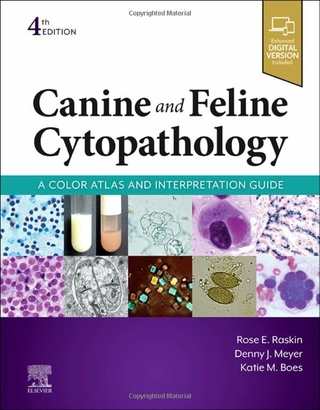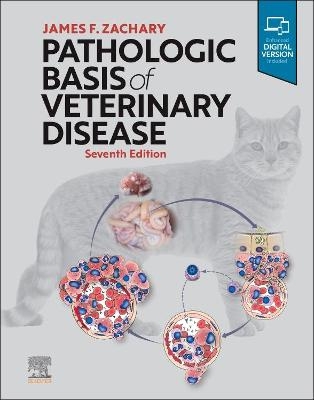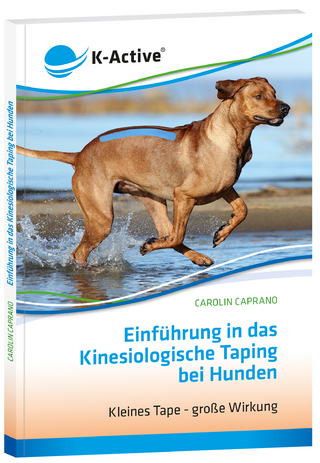Untersuchungen zum Vorkommen und zur Phänotypisierung von Mastzellen in der Synovialmembran von Hunden mit chronischen Arthritiden
Seiten
2016
|
1. Aufl.
Mensch & Buch (Verlag)
978-3-86387-722-4 (ISBN)
Mensch & Buch (Verlag)
978-3-86387-722-4 (ISBN)
- Keine Verlagsinformationen verfügbar
- Artikel merken
The aim of the present study was to examine the occurrence of mast cells (MC) and the expression of immunoglobulin E (IgE) and of histamine receptor 4 (H4R) in the synovial membrane of dogs for obtaining knowledge about their possible involvement in the synovitis of dogs with cranial cruciate ligament (CCL) rupture and of dogs with chronic polyarthritis (PA). Formalin-fixed and paraffin-embedded synovial membrane samples from 35 dogs with CCL rupture (3 groups: mild, moderate and severe synovitis), from six dogs with PA and from eight control dogs with grossly and histopathologically normal knee joints were examined using a metachromatic staining method (kresylechtviolet, KEV) and a combined immuno- and enzyme-histochemical double labelling technique for detection of chymase and tryptase. KEV-positive MC and chymase-positive, tryptase-positive and both proteases containing MC (MCC, MCT, MCCT) were quantified and the results were evaluated statistically. Additionally, the synovial membrane samples were examined immunohistochemically for IgE- and H4R-positive cells.
MC were found in the synovium of control dogs, of dogs with CCL rupture and in dogs with PA. In comparison to control dogs, dogs with CCL rupture had statistically significant more MC. In dogs with CCL rupture, mostly MCC, and in decreasing counts, MCT and MCCT were present. The finding that significantly more MCC were present in dogs with CCL rupture being associated with an increased degree of inflammation suggests that the protease chymase leads to an increase of the permeability of blood vessels thereby supporting the influx of inflammatory cells into the synovium. Also in dogs with polyarthritis MCC were the most frequently present mast cells type while MCT and MCCT were found less frequently. However, significant differences between control dogs and dogs with PA were not found which is possibly due to the small number of PA cases examined. In comparison with control dogs a higher number of IgE-and H4R-positive MC was detected in dogs with CCL rupture and PA, although the results were only statistically significant in dogs with CCL rupture. On the basis of the present investigations, the possible relevance of these findings concerning the devopment and persistence of synovitis in these dogs is not clear. Das Ziel der vorliegenden Arbeit war es, das Vorkommen von Mastzellen (MC) sowie die Expression von Immunglobulin E (IgE) und Histamin-4-Rezeptor (H4R) in der Synovialmembran von Hunden zu untersuchen, um Erkenntnisse über deren mögliche Beteiligung an der Synovialitis bei Hunden mit kranialem Kreuzbandriss (KBR) und bei Hunden mit chronischer Polyarthritis (PA) zu gewinnen. Es wurden formalinfixierte und in Paraffin eingebettete Synovialmembranproben von 35 Hunden mit KBR (3 Gruppen: gering-, mittel- und hochgradige Synovialitis), von sechs Hunden mit PA und von acht Kontrollhunden mit pathologisch-anatomisch und pathologisch-histologisch unveränderten Kniegelenken mittels einer metachromatischen Färbemethode (Kresylechtviolett, KEV) und einer kombinierten immun- und enzymhistochemischen Doppelfärbemethode zum Nachweis von Chymase und Tryptase untersucht. Die KEV-positiven und die Chymase-positiven, Tryptase-positiven und beide Proteasen enthaltenden MC (MCC, MCT, MCCT) wurden quantifiziert und die Ergebnisse statistisch ausgewertet. Des Weiteren wurden die Synovialmembranproben immunhistochemisch zum Nachweis von IgE- und H4Rpositiven Zellen untersucht.
MC waren sowohl in der Synovialmembran der Kontrollhunde als auch der KBR- und PA-Hunde nachweisbar. Bei Hunden mit KBR waren signifikant mehr MC im Vergleich zu Kontrollhunden vorhanden. MCC kamen bei KBR-Hunden am häufigsten vor, in abnehmender Zahl fanden sich MCT und MCCT. Aufgrund der signifikant erhöhten Zahl von MCC im Synovialgewebe von KBR-Hunden mit erhöhtem Entzündungsgrad ist zu vermuten, dass die Protease Chymase u.a. zu einer Erhöhung der Blutgefäßpermeabilität führen und auf diese Weise den Einstrom von Entzündungszellen in die Synovialmembran unterstützen könnte. Auch bei den Hunden mit PA waren MCC am häufigsten zu finden, während MCT und MCCT in geringer Anzahl vorhanden waren. Signifikante Unterschiede zu den Kontrollhunden ergaben sich bei den PA-Hunden allerdings nicht, was möglicherweise auf die geringe Fallzahl dieser Gruppe zurückzuführen ist.
Im Vergleich mit den Kontrollhunden wurde bei Hunden mit KBR wie auch bei Hunden mit chronischer PA eine erhöhte Anzahl von IgE- und H4R-positiven Mastzellen nachgewiesen, wobei deren Zahl jedoch nur bei den KBR-Hunden statistisch signifikant erhöht war. Die mögliche Bedeutung dieser Befunde hinsichtlich der Entstehung und Persistenz der bei diesen Hunden vorliegenden Synovialitis ist aufgrund der durchgeführten Untersuchungen unklar.
MC were found in the synovium of control dogs, of dogs with CCL rupture and in dogs with PA. In comparison to control dogs, dogs with CCL rupture had statistically significant more MC. In dogs with CCL rupture, mostly MCC, and in decreasing counts, MCT and MCCT were present. The finding that significantly more MCC were present in dogs with CCL rupture being associated with an increased degree of inflammation suggests that the protease chymase leads to an increase of the permeability of blood vessels thereby supporting the influx of inflammatory cells into the synovium. Also in dogs with polyarthritis MCC were the most frequently present mast cells type while MCT and MCCT were found less frequently. However, significant differences between control dogs and dogs with PA were not found which is possibly due to the small number of PA cases examined. In comparison with control dogs a higher number of IgE-and H4R-positive MC was detected in dogs with CCL rupture and PA, although the results were only statistically significant in dogs with CCL rupture. On the basis of the present investigations, the possible relevance of these findings concerning the devopment and persistence of synovitis in these dogs is not clear. Das Ziel der vorliegenden Arbeit war es, das Vorkommen von Mastzellen (MC) sowie die Expression von Immunglobulin E (IgE) und Histamin-4-Rezeptor (H4R) in der Synovialmembran von Hunden zu untersuchen, um Erkenntnisse über deren mögliche Beteiligung an der Synovialitis bei Hunden mit kranialem Kreuzbandriss (KBR) und bei Hunden mit chronischer Polyarthritis (PA) zu gewinnen. Es wurden formalinfixierte und in Paraffin eingebettete Synovialmembranproben von 35 Hunden mit KBR (3 Gruppen: gering-, mittel- und hochgradige Synovialitis), von sechs Hunden mit PA und von acht Kontrollhunden mit pathologisch-anatomisch und pathologisch-histologisch unveränderten Kniegelenken mittels einer metachromatischen Färbemethode (Kresylechtviolett, KEV) und einer kombinierten immun- und enzymhistochemischen Doppelfärbemethode zum Nachweis von Chymase und Tryptase untersucht. Die KEV-positiven und die Chymase-positiven, Tryptase-positiven und beide Proteasen enthaltenden MC (MCC, MCT, MCCT) wurden quantifiziert und die Ergebnisse statistisch ausgewertet. Des Weiteren wurden die Synovialmembranproben immunhistochemisch zum Nachweis von IgE- und H4Rpositiven Zellen untersucht.
MC waren sowohl in der Synovialmembran der Kontrollhunde als auch der KBR- und PA-Hunde nachweisbar. Bei Hunden mit KBR waren signifikant mehr MC im Vergleich zu Kontrollhunden vorhanden. MCC kamen bei KBR-Hunden am häufigsten vor, in abnehmender Zahl fanden sich MCT und MCCT. Aufgrund der signifikant erhöhten Zahl von MCC im Synovialgewebe von KBR-Hunden mit erhöhtem Entzündungsgrad ist zu vermuten, dass die Protease Chymase u.a. zu einer Erhöhung der Blutgefäßpermeabilität führen und auf diese Weise den Einstrom von Entzündungszellen in die Synovialmembran unterstützen könnte. Auch bei den Hunden mit PA waren MCC am häufigsten zu finden, während MCT und MCCT in geringer Anzahl vorhanden waren. Signifikante Unterschiede zu den Kontrollhunden ergaben sich bei den PA-Hunden allerdings nicht, was möglicherweise auf die geringe Fallzahl dieser Gruppe zurückzuführen ist.
Im Vergleich mit den Kontrollhunden wurde bei Hunden mit KBR wie auch bei Hunden mit chronischer PA eine erhöhte Anzahl von IgE- und H4R-positiven Mastzellen nachgewiesen, wobei deren Zahl jedoch nur bei den KBR-Hunden statistisch signifikant erhöht war. Die mögliche Bedeutung dieser Befunde hinsichtlich der Entstehung und Persistenz der bei diesen Hunden vorliegenden Synovialitis ist aufgrund der durchgeführten Untersuchungen unklar.
| Erscheinungsdatum | 07.11.2016 |
|---|---|
| Verlagsort | Berlin |
| Sprache | deutsch |
| Einbandart | gebunden |
| Themenwelt | Veterinärmedizin ► Vorklinik |
| Veterinärmedizin ► Kleintier | |
| Schlagworte | chronische Arthritide • Mastzellen • MC • Synovialmembran von Hunden |
| ISBN-10 | 3-86387-722-5 / 3863877225 |
| ISBN-13 | 978-3-86387-722-4 / 9783863877224 |
| Zustand | Neuware |
| Haben Sie eine Frage zum Produkt? |
Mehr entdecken
aus dem Bereich
aus dem Bereich
A Color Atlas and Interpretation Guide
Buch | Hardcover (2022)
Saunders (Verlag)
165,80 €




